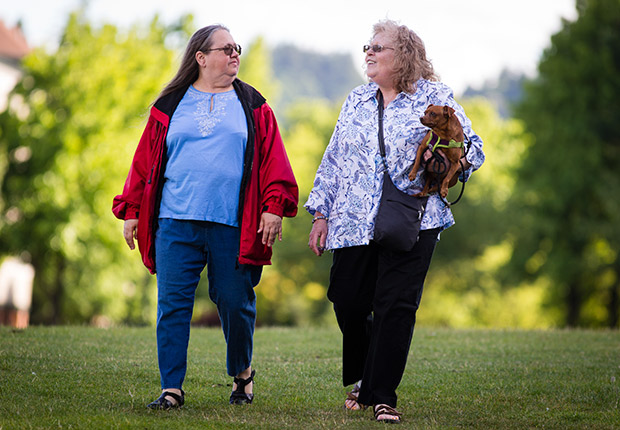AARP Hearing Center

By Lynne Terry
Kate Aubrey has volunteered for years, including feeding homeless youth and working at the Portland Art Museum. But eight years ago, she was diagnosed with an artery disease. Then she got colon cancer.
She stopped volunteering to focus on her health. Now 63, Aubrey is volunteering again with a novel program in Portland that allows participants within a network to contribute services, such as raking leaves or cutting hair, and in exchange receive help from someone else.
Aubrey signed up for one reason: to give. “I wasn’t as interested in what I could get as what I could give,” she said. “In the act of giving, you get back.”
The program, Give2Get, is the brainchild of CareOregon, a nonprofit statewide health plan organization that serves low-income, disabled and older residents. Started in October, the program aims to promote wellness among CareOregon members, reduce isolation of people with chronic health issues and spur community involvement.
“We do health care pretty well,” said Rose Englert, senior manager of regulatory affairs at CareOregon. “But there are so many other pieces to being healthy—your lifestyle, your environment, your social interactions.”
The biggest benefit
Give2Get offers services that members might not be able to afford, such as housekeeping, gardening and personal training. But its biggest benefit is psychological.
“What we’re finding is that the real value is that people feel so much less isolated,” Englert said. “They feel they have value. When you give, you have a purpose and value. That’s a big thing for people’s sense of self-worth and motivation.”
This spring about 45 people participated in the program. They included a mix of races, sexes, ages and marital status—including families with children.
Everyone undergoes a criminal background check and is screened for mental health issues, Englert said. “We make sure people can function with others in a safe way.”
Participants decide what services to offer. For each hour they give, they get one back.
Judy McClenny, 48, has participated in the program from the beginning. She, too, was primarily interested in aiding others.
She’s contributed her organizational skills, helping a woman sort through piles of paperwork. In exchange, during a difficult time, that woman lifted McClenny’s spirits with an inspiring phone call.
McClenny has also gone on walks with another member, benefiting them both.
“It’s kind of like a barter system, though it’s not with goods,” McClenny said. “It’s [giving] goodwill to another.”
AARP is not directly involved in the program but supports the philosophy behind it.
“This is part of the village model, where people in communities look out for each other,” said Jerry Cohen, AARP Oregon state director. “When you have the opportunity for folks to step up and take personal ownership for their own lifestyle while helping others, it’s a win-win.”
CareOregon hopes to expand the program, possibly partnering with health care clinics and other human services providers. As a first move, it has reached out to officials in Clackamas and Multnomah counties. A website and a smartphone app are in the works.
The organization is developing new-member surveys to see if the program curbs emergency room visits, for example, or can provide other health care services.
“We’re hypothesizing that people will use more primary care going forward,” Englert said.
Lynne Terry is a writer in Portland, Ore.































































